|
 Suillus luteus Suillus luteus
SynonymsBoletus luteus
BiostatusPresent in region - Exotic
Images (click to enlarge)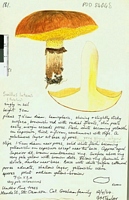
Caption: Watercolour
Owner: G.M. Taylor | 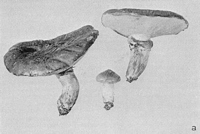
Caption: Fig. 3 - a, Suillus luteus (x 1/2) | 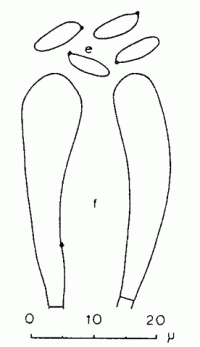
Caption: Fig 2 - e, f, Suillus luteus: e, spores; f, cystidia. | 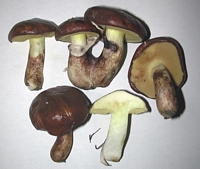
Owner: J.A. Cooper | 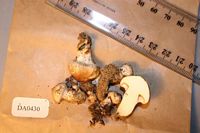
Owner: I. Dickie |
Article: Stevenson, G. (1962) [1961]. The Agaricales of New Zealand: I. Kew Bulletin 15(3): 381–385.
Description: Pileus 10-23 cm, diam., glutinous, dark brown drying lighter brown, pellicle peeling, flesh soft, yellow. Pores 5-10 mm, long X 0.5-1 mm, diam., yellow, becoming olive brown with age, usually adnate, occasionally slightly decurrent. Stipe 1.5-2.5 X 5-8 cm., with a well developed membranous ring, yellow with more or less conspicuous glandulae above, light brown below, Spores 9-10 X 3.5um.
Habitat: commonly associated throughout the country with Pinus radiata, though more abundant in the South than in the North, its distribution being somewhat complementary to that of Amanita muscaria which is also associated with this tree.
Notes: The New Zealand form of this fungus appears to be usually more robust, and with more strongly developed yellow colour than the common European forms as illustrated by Bresadola (1931) and Kallenbach (1940).
Article: McNabb, R.F.R. (1968). The Boletaceae of New Zealand. New Zealand Journal of Botany 6(2): 137-176 (http://www.rsnz.org/publish/abstracts.php).
Description: PILEUS: convex to plano-convex, 6-12 cm diam., mucilaginous,
glabrous, sometimes faintly and innately radiately fibrillose, typically dull
reddish brown or chocolate brown, occasionally golden brown, tawny, or with
greyish or purplish overtones imparted by the thick mucilage layer; cuticle
an ixotrichodermium, readily separable; margin often lacerate. HYMENOPHORE:
tubes 5-10 mm long, adnate to sub-decurrent, whitish to pallid yellow when young,
becoming deep ochre yellow at maturity; pores at first concolorous with tubes,
becoming spotted dark reddish brown, irregularly angular, 0.5-(l) mm diam. STIPE:
4-9 cm long, more or less equal, 1-2.5 cm diam., solid, pallid yellow above
annulus, brownish below; glandulae numerous apically, yellow to reddish brown,
fewer and more scattered basally; flesh white to pallid yellow: annulus conspicuous,
occasionally disintegrating with age, superior, broadly sheathing, upper surface
sordid white, lower surface with purplish tints.
SPORES: spore print yellowish brown, (Clay Color); spores
pallid melleous, elliptic-subfusiform, 7.4-9-(10) X 2.5-3.2 µm, smooth. HYMENIUM:
basidia hyaline, clavate, 14-26 X 4.5-7.5 µm, 4-spored; cystidia often crowded
in groups, hyaline or encrusted with brown, resinous material, cylindrical to
clavate, occasionally lageniform, 25-65 X 6-12 µm. HYMENOPHORAL TRAMA: bilateral,
of the Boletus subtype; clamp connections absent. CONTEXT OF PILEUS: white to
pallid yellow, unchanging on exposure to air. TASTE: mild. SMELL: not distinctive.
CHEMICAL REACTIONS: KOH on pileus—dark grey; on context of pileus—immediate
red flush turning lilac; NH4OH on pileus—dark grey; on context—immediate red
flush turning deep lilac to purplish.
Habitat: HABITAT: Gregarious or occasionally caespitose under
Pinus.
Notes: Suillus luteus
is an introduced species indigenous to the temperate zone of the northern hemisphere.
Singer (1945b)
considered that in its natural habitat, S. luteus was associated with
2-needle pines belonging to sect. Lariciones of the genus Pinus,
but later (Singer, 1965) added Picea abies and possibly Larix decidua
to the list of mycorrhizal partners. Smith and Thiers (1964) commented that
Suillus luteus occurred with Pinus and Picea in North America
and remarked that its distribution in native coniferous forests was yet to be
ascertained. It seems likely that over its natural geographical range Suillus
luteus shows a preference for certain species of 2-needle pines, but in
New Zealand is capable of forming associations in the field with species of
2-, 3-, and 5-needle pines in the absence of its preferred partners. Experimental
data support this conclusion, for in pure culture S. luteus has been
shown to form mycorrhizas with a number of 2-, 3-, and 5-needle pines as well
as Picea abies, Larix decidua, and L. occidentalis (Slipp and
Snell, 1944). Birch (1937) has proved experimentally that Suillus luteus forms
mycorrhizas with Pinus radiata in New Zealand.
Suillus luteus is an excellent edible fungus. Only
young and firm fruit-bodies should be selected, and the mucilaginous pellicle
of the pileus should first be removed.
Article: Gadgil, P.D. (in association with Dick, M.A.; Hood, I.A.; Pennycook, S.R.) (2005). Fungi on trees and shrubs in New Zealand. Fungi of New Zealand. Ngā Harore o Aotearoa 4: xi + 437 p. Hong Kong: Fungal Diversity Press.
Description: Type: Mycorrhizal Fungi; Description: Basidiomata pileate. Pileus dull reddish brown to chocolate brown, 60–120 mm in diameter, convex to plano-convex, mucilaginous; flesh white. Pore surface adnate to subdecurrent; tubes pale yellow at first becoming deep ochre yellow, 5–10 mm long; pores at first concolorous with the tubes becoming spotted dark reddish brown, angular, 0.5–1.0 mm in diameter. Stipe more or less cylindrical, pale yellow above a conspicuous white annulus, brownish below, with numerous reddish brown glandulae, 40–90 mm long. Basidiospores elliptical, 0-septate, 7–9 × 2–3 μm, smooth, pale yellow.
Distribution: Distribution: Northland, Auckland, Coromandel, Waikato, Bay of Plenty, Taupo, Wanganui, Wellington, Nelson, Buller, Westland, Marlborough Sounds, North Canterbury, Mid Canterbury, South Canterbury, Dunedin, Southland, Chatham Islands.; 1st Record: Birch (1937: as Boletus luteus).
|